
In firearm designs, the term single-shot refers to guns that can hold only a single round of ammunition inside and thus must be reloaded manually after every shot. Compared to multi-shot repeating firearms ("repeaters"), single-shot designs have no moving parts other than the trigger, hammer/firing pin or frizzen, and therefore do not need a sizable receiver behind the barrel to accommodate a moving action, making them far less complex and more robust than revolvers or magazine/belt-fed firearms, but also with much slower rates of fire.
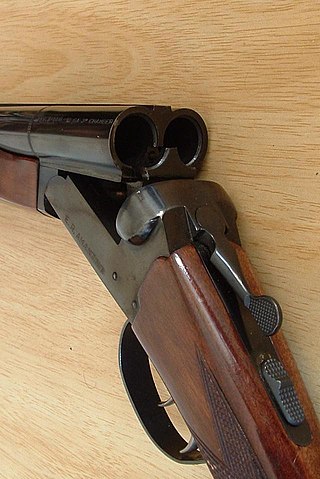
In firearms terminology, an action is the functional mechanism of a breechloading firearm that handles the ammunition cartridges, or the method by which that mechanism works. Actions are technically not present on muzzleloaders, as all those are single-shot firearms with a closed off breech with the powder and projectile manually loaded from the muzzle. Instead, the muzzleloader ignition mechanism is referred to as the lock.

An air gun or airgun is a gun that uses energy from compressed air or other gases that are mechanically pressurized and then released to propel and accelerate projectiles, similar to the principle of the primitive blowgun. This is in contrast to a firearm, which shoots projectiles using energy generated via exothermic combustion (detonation) of chemical propellants, most often black powder or smokeless powder.
Airsoft, also known as survival game in Japan where it was popular, is a team-based shooting game in which participants eliminate opposing players out of play by shooting them with spherical plastic projectiles shot from airsoft guns.

A BB gun is a type of air gun designed to shoot metallic spherical projectiles called BBs, which are approximately the same size as BB-size lead birdshot used in shotguns. Modern BB guns usually have a smoothbore barrel with a 4.5 mm (0.177 in) caliber, and use steel balls that measure 4.3–4.4 mm (0.171–0.173 in) in diameter and 0.33–0.35 g (5.1–5.4 gr) in weight, usually zinc- or copper-plated for corrosion resistance. Some manufacturers still make the slightly larger traditional lead balls that weigh around 0.48–0.50 g (7.4–7.7 gr), which are generally intended for use in rifled barrels.
Tippmann is an American manufacturer of paintball markers and paintball equipment, including military simulation (MilSim) kits. Tippmann Industrial Products, a related company manufactures manual and pneumatic heavy-duty sewing machines primarily used for leather, other leather-related equipment, and some industrial products. Originally a family-owned business run from Fort Wayne, Indiana, in 2004 Dennis Tippmann Sr. sold a majority ownership stake to Summit Partners, a private equity firm. Tippmann designed one of the first automatic markers, the use of refillable air systems in place of 12 gram cartridges, the "Cyclone Feed" system, the "Flatline" barrel, and the Tippmann C-3, the first propane-powered marker.
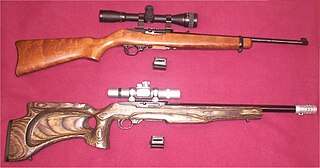
Accurizing is the process of improving the accuracy and precision of a gun.
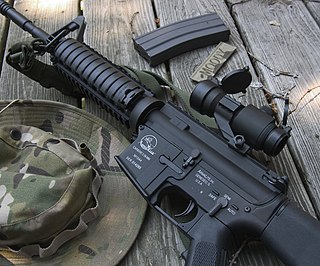
Airsoft guns are replica guns used in airsoft sports. They are a special type of low-power smoothbore air guns designed to shoot non-metallic spherical projectiles (bb) often colloquially referred to as "BBs", which are typically made of plastic or biodegradable resin materials. Airsoft gun powerplants are designed to have low muzzle energy ratings and the pellets have significantly less penetrative and stopping power than conventional airguns, and are generally safe for competitive sporting and recreational purposes if proper protective gear is worn.

Crosman Corporation is an American designer, manufacturer and supplier of shooting sport products, with a long-standing presence in airgun design and a tradition of producing pellet and BB guns. Crosman is also a producer of many varieties of airgun and airsoft ammunition and CO2 Powerlet cartridges. In addition, Crosman sells branded, licensed products as well as a variety of airsoft guns.
The Marlin Model 336 is a lever-action rifle and carbine made by Marlin Firearms. Since its introduction in 1948, it has been offered in a number of different calibers and barrel lengths, but is commonly chambered in .30-30 Winchester or .35 Remington, using a 20- or 24-inch barrel. Currently, several models with a 16-, 19- and 20-inch barrels are available in .30-30 Winchester. The Model 336 is now back in production as of March 27, 2023.

Daisy Outdoor Products is an American airgun manufacturer known particularly for their lines of BB guns. It was formed in 1882 initially as the Plymouth Iron Windmill Company in Plymouth, Michigan, to manufacture steel windmills, and from 1888 started bundling BB-caliber air guns with each windmill purchase as a sales promotion. With the unrivaled popularity of their 1888-model Daisy BB Guns, the company changed the name to Daisy Manufacturing Company in 1895 and switched their business to solely producing air guns for sale. Throughout the 20th century, Daisy has been known as a company that makes and sells BB guns and pellet youth rifles. Their Red Ryder BB Gun is perhaps the best known and longest production item, which has been featured in many TV shows and movies since its introduction in the spring of 1940.

The Remington XP-100 is a bolt-action pistol produced by Remington Arms from 1963 to 1998. The XP-100 was one of the first handguns designed for long-range shooting and introduced the .221 Fireball and 6×45mm. The XP-100 was noted for its accuracy and is still viewed as competitive today in the sport of handgun varminting, which it helped create, as well as in metallic silhouette shooting.
The CCI Phantom is a Nelson-based pump action paintball marker developed and produced by Mike Casady. Production began in 1987 after about six months of prototype work. The name for the marker was derived from the much more stealth-oriented and drawn-out style of play that was typical when the game was first developing. The Phantom was designed to be powered by a single 12-gram CO2 Powerlet, but larger tanks may also be used by removing the powerlet adapter or using a dummy powerlet. When first introduced the marker featured a fixed barrel assembly referred to as a "unibody" combined with a modified Crosman air pistol frame and brass bead sight. However, since roughly 1989 the body and barrel of the marker have been two distinct parts and no longer feature the bead style sight. The marker is also capable of supporting bulk gravity fed hoppers by using a different breach type. The Phantom is one of only a handful of readily available markers acceptable for use in the various forms of stock class paintball. However, because the Phantom is capable of auto-triggering and features barrel porting it is considered to be a modified stock class marker.

A pellet is a non-spherical projectile designed to be shot from an air gun, and an airgun that shoots such pellets is commonly known as a pellet gun. Air gun pellets differ from bullets and shot used in firearms in terms of the pressures encountered; airguns operate at pressures as low as 50 atmospheres, while firearms operate at thousands of atmospheres. Airguns generally use a slightly undersized projectile that is designed to obturate upon shooting so as to seal the bore, and engage the rifling; firearms have sufficient pressure to force a slightly oversized bullet to fit the bore in order to form a tight seal. Since pellets may be shot through a smoothbore barrel, they are often designed to be inherently stable, much like the Foster slugs used in smoothbore shotguns.

The Crosman 2100B is an American-made pneumatic air gun that is manufactured for small game hunting, large and small pest control, and target shooting.
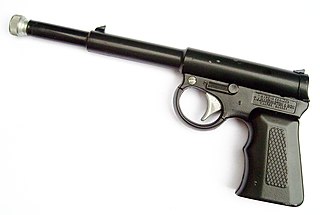
The Gat air pistol was an air pistol of British origin. The pistol can fire .177 pellets, ball bearings, darts and also corks. The Gat pistol has also become popular in funfairs and arcade stalls. Another example is the Gat air rifle, produced from 1988.
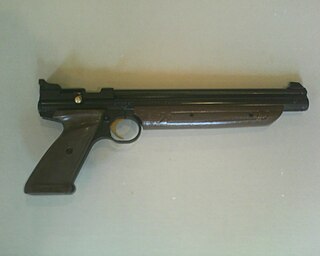
The Crosman model 1322Medalist .22 Caliber Pellet Air Pistol was a single-shot, bolt-action loading, pneumatic pump-action .22-caliber air pistol, featuring a button-rifled 10.1-in. (256 mm) steel barrel and checkered plastic grips. The 1322 was introduced in 1977 by Crosman as a general-purpose air pistol for target practice and small game hunting. It was in production, in three separate manufacturing versions, until 2004, when it was discontinued from sale in the U.S.A. In 2012 the gun has been reintroduced by Crosman.
The BSA Mercury was a break barrel, spring powered, Air Rifle first produced in 1972 by the Birmingham Small Arms Company and then Gamo (UK) Limited. It was manufactured in .177 (4.5 mm) .22 (5.5 mm) and .25 (6.35 mm), the latter named the "635 Magnum". The Mercury was marketed between the BSA Meteor and AirSporter models and was a light, easy to use rifle, giving a "just under legal limit UK power" of 11.5 ft•lbf of energy.
The Weihrauch HW 35 is a break barrel, spring-powered, air rifle first produced in 1951 by Weihrauch & Weihrauch located in Mellrichstadt, Bavaria. Available in 4,5 mm and 5,5 mm calibers, with standard and carbine (K) length barrels, it has been in continuous production since its launch, even though the Weihrauch HW 80 superseded it in the late 1990s.
Sheridan Products Inc. was an American air gun manufacturing company. It was purchased by the Benjamin Air Rifle Company in 1977, and later purchased by Crosman in 1994.












